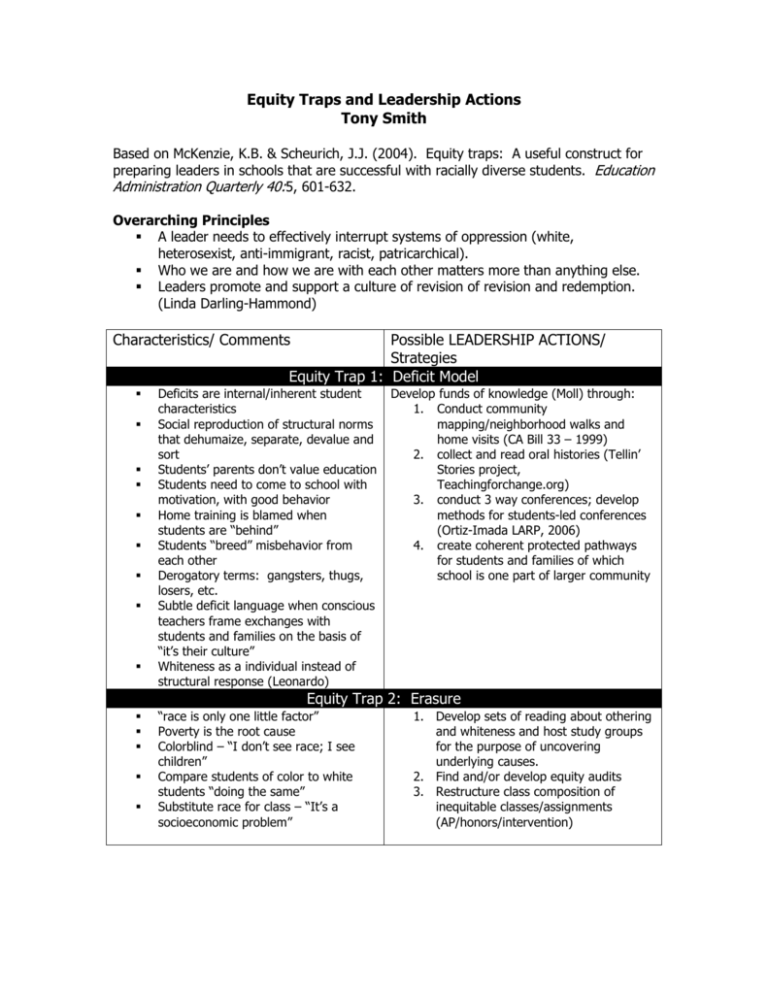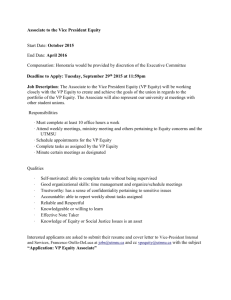Equity Traps and Leadership Actions
advertisement

Equity Traps and Leadership Actions Tony Smith Based on McKenzie, K.B. & Scheurich, J.J. (2004). Equity traps: A useful construct for preparing leaders in schools that are successful with racially diverse students. Education Administration Quarterly 40:5, 601-632. Overarching Principles A leader needs to effectively interrupt systems of oppression (white, heterosexist, anti-immigrant, racist, patricarchical). Who we are and how we are with each other matters more than anything else. Leaders promote and support a culture of revision of revision and redemption. (Linda Darling-Hammond) Characteristics/ Comments Possible LEADERSHIP ACTIONS/ Strategies Equity Trap 1: Deficit Model Deficits are internal/inherent student characteristics Social reproduction of structural norms that dehumaize, separate, devalue and sort Students’ parents don’t value education Students need to come to school with motivation, with good behavior Home training is blamed when students are “behind” Students “breed” misbehavior from each other Derogatory terms: gangsters, thugs, losers, etc. Subtle deficit language when conscious teachers frame exchanges with students and families on the basis of “it’s their culture” Whiteness as a individual instead of structural response (Leonardo) Develop funds of knowledge (Moll) through: 1. Conduct community mapping/neighborhood walks and home visits (CA Bill 33 – 1999) 2. collect and read oral histories (Tellin’ Stories project, Teachingforchange.org) 3. conduct 3 way conferences; develop methods for students-led conferences (Ortiz-Imada LARP, 2006) 4. create coherent protected pathways for students and families of which school is one part of larger community Equity Trap 2: Erasure “race is only one little factor” Poverty is the root cause Colorblind – “I don’t see race; I see children” Compare students of color to white students “doing the same” Substitute race for class – “It’s a socioeconomic problem” 1. Develop sets of reading about othering and whiteness and host study groups for the purpose of uncovering underlying causes. 2. Find and/or develop equity audits 3. Restructure class composition of inequitable classes/assignments (AP/honors/intervention) Equity Trap 3: The Gaze Surveillance is not as strong in low income racially diverse schools; teachers do not feel as responsible or accountable Treat students differently who are racially diverse and/or poor Employ the gaze against teachers who raise questions through remarks, voice tone and “look” Silencing; status quo; acceptance of social reproduction. Missionary stance: “I’m there; I’ve chosen to work with these kids” – implicitly: isn’t that enough? Reproductive effect of thoughtful persons who are fearful of stepping on the toes of other adults or causing them to get angry; they take time to weigh options and lose the moment of response Attack “cool pose”, in particular of AA males, as oppositional and respond with opposition 1. Diminish time between awareness and action. 2. Visualize allies so you do not feel alone 3. Use interview protocols that hire teachers who can articulate the beliefs and vision that is important (SEDL, Organizing for Diversity sedl.org; Haberman protocols) 4. Establish clear group norms so that everyone has a voice and no one is silenced 5. Communicate vision and expectations daily by maintaining visibility and observing classrooms 6. Use exit notes or other ways to collect critical feedback 7. Develop reciprocal teacher classroom visits 8. Use cognitive coaching to address beliefs and attitudes (Garmstorm, The Adaptive Classroom) Equity Trap 4: Paralogical Beliefs and Behaviors Illogical conclusion based on facts (which may be true or somewhat false or misconstrued) Intersects with deficit trap “I am not successful because the students are…..” or the “parents are….” Self deception and self-fulfilling prophecy tone Hard to see oneself as “bad” or agency of oppression; therefore look outside of self for explanation. 1. 2. 3. 4. 5. 6. Develop lateral accountability among peers. Develop ways of responding to students who have internalized the paralogical stance and oppression, as they may not change immediately Peer classroom visits to make teaching transparent Coaching by master teachers who address faulty logic Demonstration lessons by coaches Build equity allies at school strategically and consistently to overcome our sense of inadequacy or complacency




